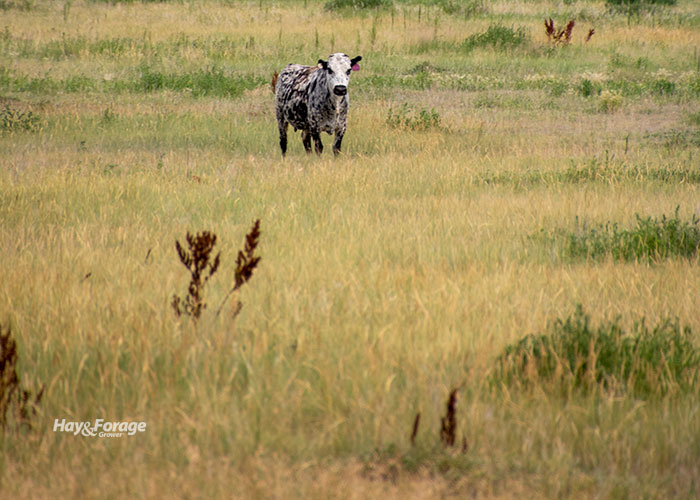
In recent weeks, much of the U.S. has experienced high temperatures with little relief from rainfall. David Barker with The Ohio State University states, “Although the experts don’t all agree if this period of dry weather meets the definition of a drought (in all areas), there is no doubt that pasture growth will slow to zero.” This leads to the question: How should we be grazing our pastures in mid-summer?
Avoid overgrazing
Close grazing exacerbates the effects of water stress in pastures. “Leaf removal by grazing or mowing results in a roughly similar proportion of root death,” Barker explains. With adequate moisture, roots recover quickly from this setback. Optimum grazing height and management varies with pasture species, but grazing below 2 or 3 inches will accelerate drought effects in pastures.
Toxicity
Between the ergot alkaloids in tall fescue and nitrate buildup in warm-season grasses, farmers really have to be on top of their management game to prevent poisoning in cattle and other grazing livestock.
He warns, “Drought can result in a triple whammy in respect to endophyte: 1. Ergovaline (the toxic alkaloid) levels are elevated compared to spring; 2. Livestock graze nearer the base of plants where endophyte and alkaloids are the most concentrated; and 3. Seedheads typically have higher alkaloid levels than leaves.”
Barker highly recommends nitrate testing, and most labs will offer a faster option for forage nitrate tests during the summer. “The regrowth of warm-season grasses that results from the first rainfall after drought can especially have elevated nitrate levels,” he explains. Barker also notes that the toxin limit for young stock can be lower than adult stock.
Give and take
Upon relief of a drought period, pastures and livestock experience compensatory growth. Barker urges farmers to be ready with nitrogen (N). “Strategic use of N, early in the recovery from drought, can regain some of your losses, but don’t apply too early since volatilization losses could be high without rain to ensure incorporation of N,” he says.
To reduce livestock pressure on pastures, consider selling unproductive stock or feeding additional silage, hay, or grain. Making hard decisions early in the season can provide relief later. During extreme drought and low forage performance situations, productive livestock may also need to be sold to effectively reduce the grazing pressure on pastures.
Plan for the future
In a pinch, quick and dirty solutions can help get you through the rough patches, but planning for the future can help you avoid the rough patches all together. “The best drought strategy is to plan in advance; it’s not if it gets dry, but when it gets dry,” Barker theorized.
Here are some ways you can prepare for drought in advance:
• Spring-planted crops such as brassicas, grazing corn, and brown midrib sorghum-sudangrass can fill the summer slump.
• Warm-season grass stands are not always high quality, but they will be more than adequate to keep livestock maintained during summer.
• Use drought-tolerant pasture mixes – species including alfalfa, chicory, red clover, orchardgrass, and tall fescue have good drought tolerance and can help during dry summers. Perennial ryegrass, Kentucky bluegrass, and white clover have poor drought tolerance and go dormant very quickly.
• Surplus spring growth can reduce tiller density and summer growth potential – there is evidence that closer spring grazing can benefit summer production.
• Early calving could get your calves weaned and off your property before the drought hits. Dry cows on a maintenance diet have a much lower feed requirement.
• Learn feed budgeting. Using a feed budgeting and monitoring system can identify feed deficits up to three weeks earlier than without such a system. This advance notice can give you critical time to make a plan before the effects of a drought actually hit.
• Observe changes in your pasture. What has survived the drought? Are these the grasses and legumes you want? Does your management favor these forage species?
• Maintain a sacrifice area, a heavy-use pad or a paddock, which will be utilized in extreme situations while allowing pastures to regrow.
• Maintain good fertility levels. Test soils and adjust pH, phosphorus, and potassium accordingly. Strategically apply nitrogen to support forage growth.
• Consider frost seeding legumes in February or March.
• Evaluate the need for weed control. Carefully consider weed pressure and herbicide use next year. Some problem perennials may need to be controlled.

C.J. Weddle is serving as the 2020 Hay & Forage Grower editorial intern. She currently attends Mississippi State University, majoring in agricultural education, leadership, and communications. She grew up on a farm in Vardaman, Miss., where her family raises sweet potatoes and soybeans.

